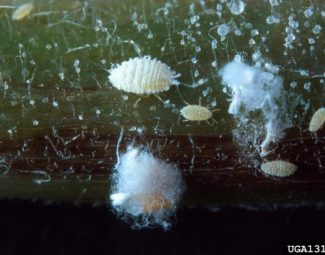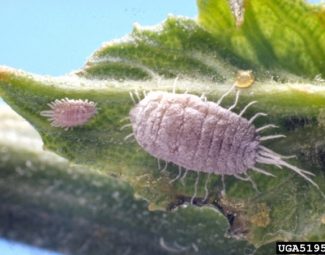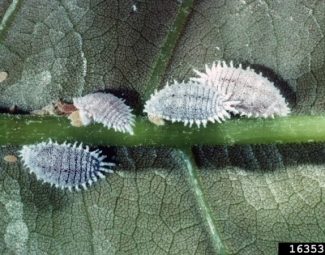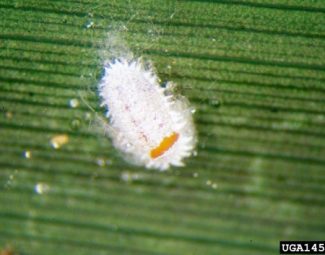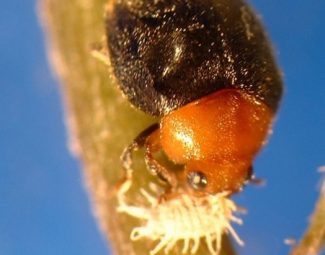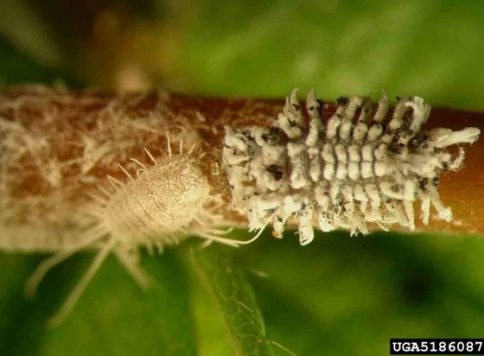Mealybug
Insect Summary Report
Pseudococcidae
General Information
- Mealybug is a soft-bodied scale-like insect. Generally has waxy coating on outer surface that gives a cottony appearance and filamentous appendages that project from the perimeter of the body.
- Wide variety of host plants. The citrus and longtailed mealybug are the most prevalent and are most often a pest of host plants in greenhouses and indoor settings. The hibiscus or “pink” mealybug has recently also become more common. The pink mealybug is easily distinguished by a red fluid that is produced when crushed.
- Closely related to whiteflies, aphids and scale insects.
- Damage hosts by piercing and sucking sap nutrients. Feeding results in stunting of growth, disfigurement of leaf formation, yellowing and death of host. Mealybug exudes honeydew substance that promotes growth of black sooty fungus on surface of leaves, inhibiting photosynthesis.
- Citrus mealybugs are capable of both sexual and asexual egg formation. Longtailed mealybugs only capable of sexual reproduction and generally takes a longer period of time to develop. Longtailed mealybugs can either lay eggs or give birth to live nymphs.
- There are other varieties of mealybugs that are ground dwelling and feed on roots rather than foliage.
- Often found in the presence of ants, which provide protection from natural predators.
Life Cycle (Up to 6 Generations/Year)
- Eggs… (2-10 Days) Citrus mealybugs lay eggs inside waxy coating giving cottony appearance.
- Nymph… Searches for suitable feeding site. Pierces surface of host plant to find plant sap source. Sucks plant nutrients from host and exudes sticky honeydew substance that promotes growth of sooty mold.
- Pupa… Only in species with winged males.
- Adults… Females do not change body structure from nymphs. Males do change into winged “wasp-like”body forms and do not feed on plant structures as adults. Citrus mealybug female can produce up to 600 eggs. Longtailed females produce approx. 200 eggs. Multiple life stages are likely due to be present due to overlapping of generations.
Overwintering Strategy
- Overwinter as nymphs.
Monitoring
- Visual inspection of plants for egg sacs and nymphs
- Sticky traps baited with pheromone traps will attract adults – males only.
Organic Control
- General Info
- Commercially available natural predators include the Mealybug Destroyer Cryptolaemus montrouzieri Mulsant. Nymphs of this predator look very similar to mealybug nymphs.
- Leptomastix dactylopii and Anagraphus ssp.are commercially available parasitic wasps that can be released to enhance control of natural predators.
- Manual removal of nymphs.
- Application of alcohol swabs to nymphs and egg sacs.
- Commonly Used Products
- Ferti-Neem Oil
- Ferti-Organics Karanja Oil
- Biorepel (Garlic Oil)
- Neemix 4.5 (Botanical)
- Ecotrol Plus (Rosemary and other essential oils)
- Pyganic 1.4 (Botanical)
- Pyganic 5.0 (Botanical)
- Various Oils: Trilogy, Tritek, Ecotrol Plus, Cedar
- Soaps: Des-X
- Mycotrol ESO (Biological)
- BoteGHA ES (Biological)
Cultural Control
- Maintain good fertility and mineral balance in plants. Identify macro- and micronutrient deficiencies by performing plant tissue and soil analysis. Adjust for deficiencies with foliar and soil applied applications of appropriate fertilizers.
- If transplants are used, inspect them before purchase for infestation and egg deposition.
- Destroy vegetative materials and crop residue immediately after harvest by disking or burning.
- Limit or eliminate physical touching of plants to control spread of infestations between plants.
- Thoroughly clean all equipment that is used in infested areas.
More Images of the Mealybug
Bibliography
- Images by Whitney Cranshaw, Colorado State University, Bugwood.org (citrus mealybug and grape mealybug infestation on tree)
- Image by Peggy Greb, USDA Agricultural Research Center, Bugwood.org (papaya mealybugs)
- Images by John A. Weidhass, Virginia Polytechnic Institute and State University, Bugwood.org (nymphs and adult mealybugs clustered at feeding site)
- Images by Sonya Broughton, Department of Agriculture & Food Western Australia, Bugwood.org (mealybug destroyers)
- Images by Jeffrey W. Lotz, Florida Department of Agriculture and Consumer Services, Bugwood.org (pink hibiscus mealybug infestation and longtailed mealybug)
- Image by Chazz Hesselein, Alabama Cooperative Extension System, Bugwood.org (adult longtailed mealybug)
- Lindquist, R., Ohio State University Department of Entomology, Ohio Floriculture Online – Mealybugs. (Conventional control, lifecycle of longtailed mealybug, natural control) http://floriculture.osu.edu/archive/oct97/mealybug.html
- Kearns, David; Glenn Wright, and John Loghry. University of Arizona Cooperative Extension, Citrus Mealybug (Planococcus citri) (Conventional control, life cycle of citrus mealybug, monitoring, overwintering) http://cals.arizona.edu/crops/citrus/insects/citrusinsect.html


